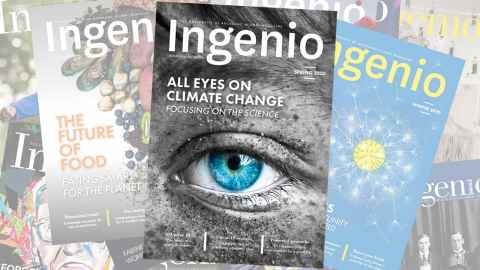Climate change challenge: all eyes on the blue marble
28 October 2020
Aotearoa has committed to net-zero emissions of all greenhouse gases, other than biogenic methane, by 2050. Is that enough? Finlay Macdonald talks to scientists, including those in the Climate Science Initiative.
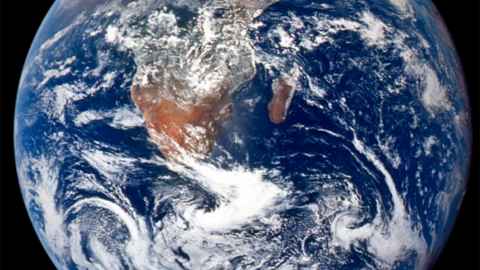
Few countries were ready for the pandemic that’s hit the world. So has the Covid-19 crisis taught us anything about ameliorating the threats of climate change? The world is heading to be 1 degree warmer in 2040, leading to fires, floods, heatwaves and scarcity of water and food. Aotearoa has committed to net-zero emissions of all greenhouse gases, other than biogenic methane, by 2050.
But is that enough? FINLAY MACDONALD talks to scientists at the University, including those involved in the new Climate Science Initiative, who are committed to Earth’s survival.
WHEN Professor David Noone explains the hydrologic cycle in lectures, he likes to illustrate it with the famous image of Earth, the “blue marble”, taken from space by the Apollo 17 astronauts in 1972. Yes, there are conventional infographics that explain the way water moves in and out of the atmosphere quite well, but that first space ‘selfie’ really has it all.
“I’ve been using it for years and it’s very effective,” says the Buckley-Glavish Professor of Climate Physics.
“I often ask the question, when you look at this thing, what do you see? You see the water cycle everywhere. You see the clouds, Antarctica, the ocean is dark blue, you see the landscape, the brown bits don’t have water, the green bits do. You see all sorts of subtle characteristics.”
More than that, though, you see home.
“When you look at that picture of Earth, you think, yeah, that’s actually where I live. That’s my home. So there is that connection. And I show that because that’s how I feel. I’m delighted to share that with people.”
The image reinforces the sense of fragility the blue marble faces with climate change. The headlines are about global warming and rising seas, but we are belatedly realising that climate change affects every aspect of society. A considered response to climate change requires a multi-faceted, audacious approach that needs to engage researchers across many disciplines.
That perspective is behind the establishment of the University’s new Climate Science Initiative, which David came to Auckland to lead. Not only in the sense that we are all connected to our planet and what happens as its climate changes, but also that many scientific disciplines and fields of research must combine and connect for us to understand and mitigate the effects of that change.
The potential to bring scientists and their work together to create something greater than the sum of its parts was what attracted the Australian-born scientist from his previous position in the College of Earth, Ocean and Atmospheric Sciences at Oregon State University. He detects a global shift in the climate science community from pure research towards “actionable science” that contributes tangibly to planning and policy.
“There are voices across the Pacific, New Zealand being central to that, that speak loudly together. And we represent a group where climate is very strongly influencing ways of life, and where the survival of communities in the future is really threatened.
“This part of the world is a hotspot for these changes. One of the things I’m really excited about is what we can do here to grow a broad community, a collective alliance that, as well as being science-focused, is evidence-based and rigorous.”
The Climate Science Initiative, underwritten by the Vice-Chancellor’s Strategic Development Fund, aims to foster excellence in research and focused expertise and training in quantitative climate science. It is working to facilitate collaboration, encourage interdisciplinary research, train the next generation of leaders in climate science, and engage the public in climate science that informs public policy.
Professor Richard Easther, Head of Physics in the Faculty of Science, says the University has an essential role in shaping future research.
“One of the questions we ask ourselves as a department, a faculty and as a university,” he says, “is what are the big questions we’re facing as a society in the 21st century, and where can we make a difference? Also, what are the most intellectually challenging questions for us as scientists and researchers?
“For physicists, climate is very much one of those things … and using that understanding to predict how [the climate] is going to change as we force it in particular directions is obviously critical in the 21st century. In the longer term, it’s seeing how that knowledge can contribute to the formation of policy by experts, but also by society at large.
“The other part of it, possibly outside of this initiative, but it’s definitely something we have an eye on as physicists, is what can we do to develop technologies that will mitigate the impact of climate change or allow us to move away from the use of fossil fuels?”
The emphasis on research and knowledge that has application in the real world is hardly unique to climate science, of course. But the urgency with which that applicability is pursued is perhaps what distinguishes the field.
The Climate Science Initiative research responds to urgent real-world goals. Aotearoa has committed to net-zero emissions of all greenhouse gases, other than biogenic methane, by 2050.
“When I was in school back in the last millennium, climate change was a much simpler thing,” says David. “It was going to happen in the future. Now we have almost the reverse problem. It’s vastly more complicated because it’s happening now, and we need solutions now.
“The priorities are shifting towards things that have time horizons, where actions could be taken, policies could be put in place, where solutions can be found quite quickly.”
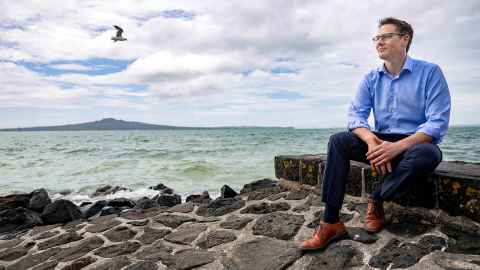
We represent a group where climate is very strongly influencing ways of life, and where the survival of communities in the future is really threatened.
IMPACT ON ASIA PACIFIC
In the Pacific region, those solutions could be required within three decades. A recent paper in the University of Oxford’s Forced Migration Review referenced research that the Pacific Islands’ vulnerability to the impact of climate change could see up to 1.7 million people in the region migrate or be displaced by 2050.
Associate Professor Jay Marlowe is co-founder of the newly established Centre for Asia Pacific Refugee Studies, Tāwhārau Whakaumu, a research centre within the Faculty of Education and Social Work. The centre is looking to develop responses to both conflict and climate-induced displacement across the Asia Pacific region, which he says aren’t necessarily distinct.
“If we think about climate change and the movement of large numbers of people, particularly in cases where there might be scarce resources, it’s often the politics of difference that justifies who gets access to resources and who doesn’t.
“Where it may have been about a lack of arable land due to drought, suddenly access is about your ethnicity or nationality or religion,” he says.
“Social grouping or political opinions put you in certain groups and those groups either bestow particular privileges or make it so you’re effectively excluded from having access. That creates context for conflict.”
He says an example would be the Syrian civil war.
“There was a major drought in the Fertile Crescent that preceded that civil war, likewise recent conflicts within Somalia tell a similar tale.”
Jay says close to 25 million people around the world were displaced last year as a result of severe weather events. Seven of the countries most at risk to such weather disasters were in the Pacific.
He says many of the climate-change hazards that could displace communities in the Pacific Islands are slow-onset events, but mean we should examine the contemporary ways displacement in our region could occur.
“Salinification of the water, rising sea level, drying out of land. We need to consider at what point these things cross the threshold and create a danger to life? What point do we ascertain that there aren’t solutions within a country to respond to it?”
Jay says when people start crossing borders, or even within borders, it creates political tension. He says countries such as Fiji are taking proactive steps to anticipate how, if coastal communities have to move, it can be done in a way that doesn’t create conflict.
In 2019, the United Nations recognised that in situations where sending people back to their own country would violate their lives, receiving states have an obligation to protect them.
“But it’s just been far too easy to kick the can down the road. We’re coming to the point where we can’t just keep kicking the can, there are too many cans in front of us and we need to start picking them up.”
EFFECTS ON MENTAL HEALTH
One issue still being picked up is the effect of climate change on mental health.
Dr Jemaima Tiatia-Seath is Co-head of School, Te Wānanga o Waipapa, School of Māori Studies and Pacific Studies. She began a three-year project in 2019, funded by the Health Research Council, looking at how best New Zealand can help support the mental health and well-being needs of Pacific climate-change migrants.
Jemaima says Pacific peoples forced to relocate face a higher risk of mental health and well-being challenges brought on by the stress of climate-induced migration, including cultural loss.
“If they move to New Zealand, our health system needs to be prepared to deal with that,” she says.
If border restrictions are ongoing as a result of Covid-19, that will add an extra level of stress to those wanting to flee the effects of cyclones, floods or drought.
“Climate change has a direct impact on the mental health of those in the Pacific. With the increased frequency and severity of natural disasters, there’s a compounding effect.
“Natural disasters also disrupt access to public health services and can obstruct access to medication and care.
“Take, for example, Cyclone Heta in 2004, the impact of which is still being felt by Niueans. There’s the historical trauma of loss for some, as well as people’s livelihoods and the infrastructure that was destroyed.”
“It’s also important to frame research in a way that makes sense to Pacific peoples.
“For instance, if there is climate change-induced migration, and a family must uproot, they would be leaving behind their loved ones and the burial grounds of their blood, their being, their everything.
“Their being is completely embedded in the land and with their ancestors … for most, there’s spiritual and historical connection.
“That’s important to most Pacific peoples and it doesn’t take a rocket scientist to establish that there will be an impact upon people’s well-being in relation to such disconnection and loss.”
WATER RESOURCES
Another issue in the Pacific is access to water. David Noone says there are “a couple of really dominant areas where there’s a critical need for work, and actionable outcomes are needed”.
Climate change is already being felt not just on low-lying islands and atolls of the Pacific region, but also on higher mountainous islands.
“Water availability is remarkably scarce, and the quality of water therefore becomes important,” says David.
“There’s inundation by seawater, which influences water supplies, variability in rainfall and shifting rainfall patterns. There are issues associated with all of that. Ecosystems themselves tend to filter clean water. If those have been degraded by all sorts of different uses or lack of ability of ecosystems to adapt to the new environment, again the water is threatened.”
The other critical area for research is close to home – commercial agriculture and the likely impact of drought and water shortages, at the same time as the population is increasing and, with it, the demand for food.
As with sea-level rise and weather events in the Pacific, we are already witnessing the tangible impact of climate change. David recalls a lake near his hometown of Ballarat, north-west of Melbourne, that dried up a few years ago. Similarly, Cape Town in South Africa essentially ran out of water in 2018.
“These are quite shocking events,” David says. “How we use water has to become increasingly more efficient – despite the fact that as temperatures rise, evaporation rates rise very quickly. There are real challenges there.”
Associate Professor Anthony Fowler, from the School of Environment, agrees but cautions against attributing Auckland’s current water shortage entirely to climate change. He says few lessons have been learned since Auckland’s drought of 1994.
“I’m not saying that we shouldn’t panic at all. I did my PhD on climate change impacts on water resources in the Auckland region some time ago, so it’s been a concern of mine for a long time. The climate-change scenarios are for a decrease in rainfall and the record for the past few decades is consistent with that. In addition, we have increasing temperatures, which increases evaporation. We’re right to be concerned.”
Climate change has a direct impact on the mental health of those in the Pacific. With the increased frequency and severity of natural disasters, there’s a compounding effect.

DELICATE CONNECTIONS
David Noone’s research focuses on the water cycle and how land surfaces and the atmosphere work together – a deep connection that he says is still poorly understood.
In turn, there’s a delicate connection between the water moving between land and atmosphere and various other greenhouse gases, including carbon dioxide and methane. Better understanding of these interactions will mean better data on which to base climate models, and therefore our ability to predict and mitigate the impact of change.
Richard Easther points out that climate models are not, as some may believe, simply best guesses about what will happen in the future. They are built on the kind of deep scientific research already underway, and which the Climate Science Initiative and the various disciplines it embraces aim to accelerate.
“What you’re doing is fundamental physics,” he says. “Equations that describe fluids and radiation, the way the radiation impinges on the atmosphere, how it interacts with the molecules it finds there.
“There’s quantum mechanics, there’s thermodynamics, there’s fluid mechanics. These are part of the bedrock understanding of the world that physics provides … The challenge is being able to implement those as computer code in a way that’s tractable, that allows us to get granular information that’s reliable over a long period of time.”
Take clouds, for instance. We know that as the world heats, water is picked up from the oceans more quickly, which forms clouds, which reflect radiation back into space … how do these feedback loops affect rainfall patterns, regional temperature variation and sea-level rise? The uncertainties inherent within these interactions, and indeed within the differences between an average 1.5 degrees and 2 degrees Celsius warming, mean the entire concept of climate change must be seen in the round, not as some inevitable linear process.
Working at this crossroads of radiation, clouds, atmospheric and oceanic circulation and the hydrological cycle is Dr Tra Dinh, also of the Physics Department, whose primary fields of research include cloud behaviour – specifically what are known as “cloud-resolving models” or CRMs. These are relatively high-resolution models used to describe cloud properties, and are useful on a regional, but not global, scale.
Global climate models (GCMs) differ in that they are lower resolution but have been invaluable in advancing our ability to understand and predict the Earth’s climate over longer time scales.
Says Tra: “Given that GCMs cannot resolve clouds explicitly, the impacts of clouds on atmospheric radiation remain the largest source of uncertainty across our predictions of global warming.”
Using a combination of both models, Tra studies how atmospheric radiation and circulation affect clouds (and vice versa) at both cloud scales and global scales. Ultimately, her research will lead to improvements in the representation of clouds within the global model. At the same time, she is studying how the water cycle changes in response to global warming – using theoretical and mathematical tools to quantify how atmospheric radiation governs the strength of atmospheric circulation, which drives condensation of water vapour and subsequent precipitation.
“Once such physical and mathematical frameworks are established, they can be used to predict with confidence how precipitation and our water resources will change with warming,” she explains.
Dr Melissa Bowen, from the School of Environment, has been immersed in the Deep South Challenge, a government initiative bringing together physical science, predictive climate modelling and social science to help guide planning and policy. Melissa has led the oceanographic project, a key component of which is measuring ocean temperatures.
“The ocean is really the flywheel in the climate system because it holds so much heat,” she says. “Over 90 percent of the heat that’s going into the climate system ends up in the ocean, and we’re actually able to measure that now.”
Key to those measurements are robotic floats that can be programmed to descend to depths of up to 2,000 metres – roughly half the overall distance to the ocean floor, and the half that is changing the fastest as a result of global warming. It is also, logically, the section of ocean most in contact with the atmosphere, from where it is drawing the heat. Within ten years, says Melissa, there will be floats that can go to the bottom to measure the darkest part of the abyss, too.
What can we do to develop technologies that will mitigate the impact of climate change or allow us to move away from the use of fossil fuels?
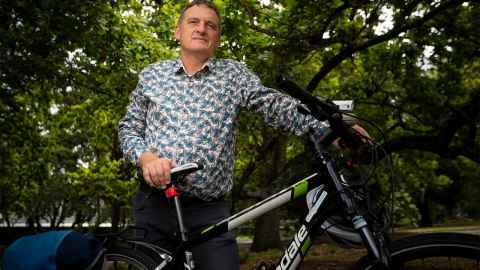
Melissa’s focus is oceanic circulation – the large waves within the ocean, not the kind on top that you surf on – and how they influence the interaction of heat between the atmosphere and the water, and how that affects climate variability. “We focus a lot on trends,” she says. “But actually there are some really big fluctuations that happen too.”
Aside from the oceans’ overall warming, there are specific changes occurring.
“What we’ve seen with the waves is that as they are coming across, they speed up the East Australian Current, which is putting warm water into the Tasman, so preconditioning us for marine heatwaves.
“But we do also think the ocean is modulating the heat transferred to the atmosphere through the dynamics of ocean circulation.”
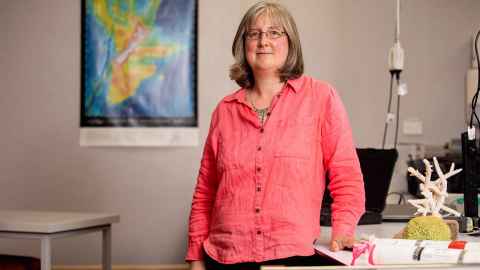
Melissa says Auckland (and New Zealand in general) is ideally placed to make significant contributions to the global network of research in the field.
“It’s great because the core group of us can get together and discuss physical climate processes. There is so much climate research going on at the University, everyone has it as a strand within their different disciplines because it is so integral now, and I really see the Climate Science Initiative as a forum to facilitate communication and collaboration.”
Tra Dinh echoes that sentiment.
“Collaboration among scientists in climate science and related fields will allow us to accelerate progress in research and promote our research in New Zealand and worldwide.”
Richard Easther also sees the importance of the centre as a conduit for much-needed expertise as climate science becomes central to planning and management at national, regional and international levels.
“There’s no other big university between us and the equator,” he points out. “As a Pacific country, we engage with a large slice of the world. And so part of our brief is that we generate the people – for example, every local council in New Zealand is going to need people who understand climate science. They’re not necessarily going to be researchers, but we’re going to be generating a deeper pool of expertise to draw on.”
As Richard puts it, we have already “cooked” a certain amount of change into the climate system, so we need to accept the world as it now is and will be. It’s one of the reasons he rides a bike – partly because it makes sense in Auckland and keeps him fit, but also because it’s “my reminder to myself that in fact the climate is changing”.
The more urgent questions now revolve around adaptation and preparation, and what kind of world we want our children and grandchildren to inhabit. One of the dangers, he agrees, is the sense of pessimism – the “doomerism” – that arises from relentless negative reportage about worst-case-scenario predictions.
“Because all of this doesn’t mean there aren’t solvable problems,” says Richard.
Science is innately optimistic, anyway, at least in the sense that seeking solutions to problems is its essence. And, as David Noone suggests, if blanket coverage of climate change inspires young people to stick with science at school and into tertiary study, that would be a good thing.
“It sometimes seems that science is somehow external to the human psyche,” he says. “I think we’re all scientists, it’s just that some people get degrees in it. Everybody is inquisitive. We’re all in this together. That’s one blue marble that we stare at from space. It’s not the scientific Earth and the other Earth. It’s one.”
Additional reporting Denise Montgomery
This article is the cover feature in Ingenio magazine's Spring 2020 edition.
